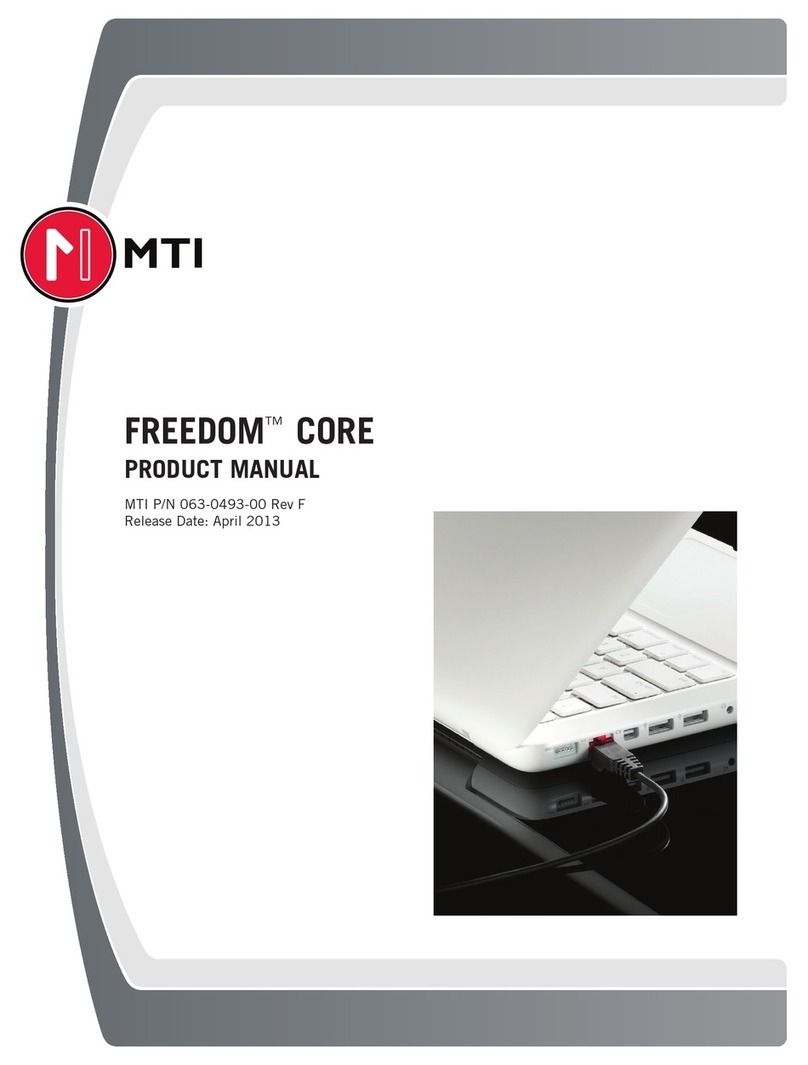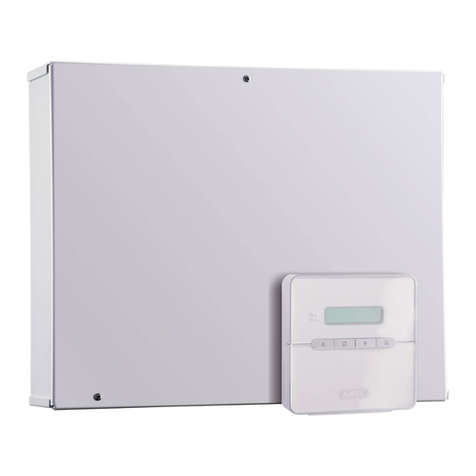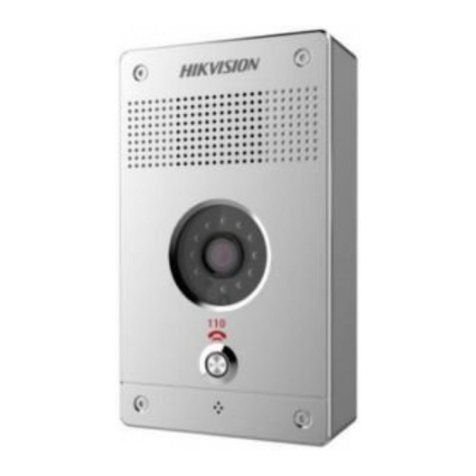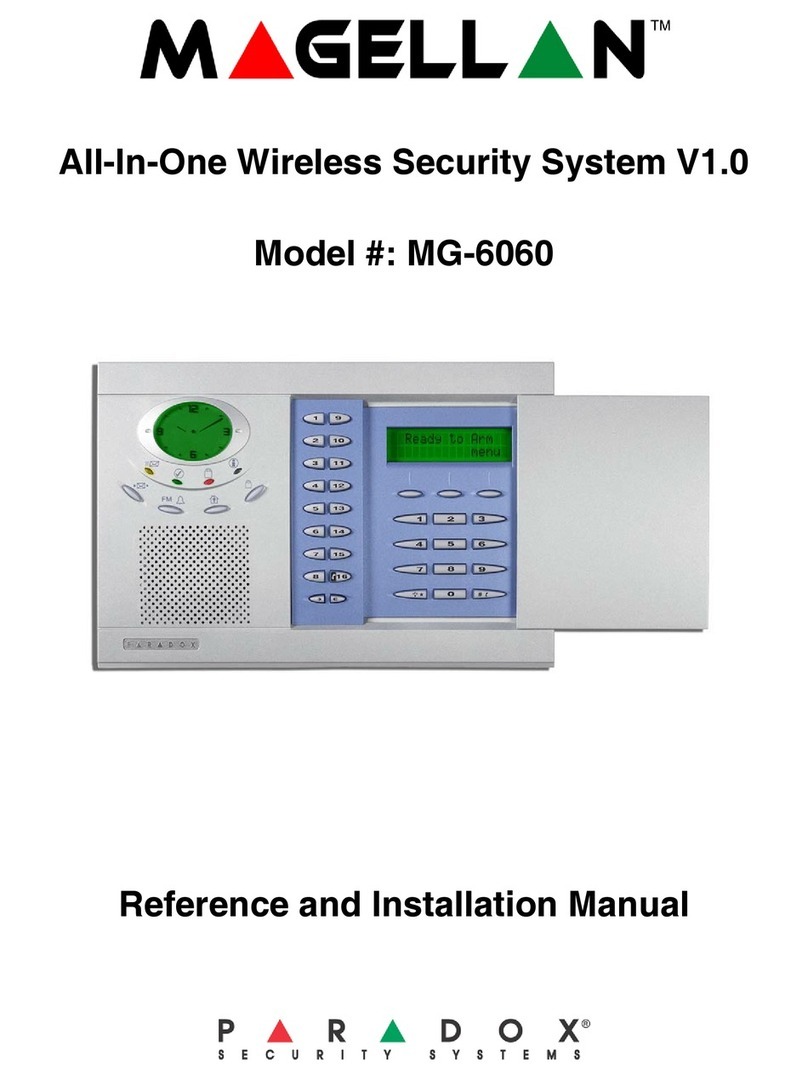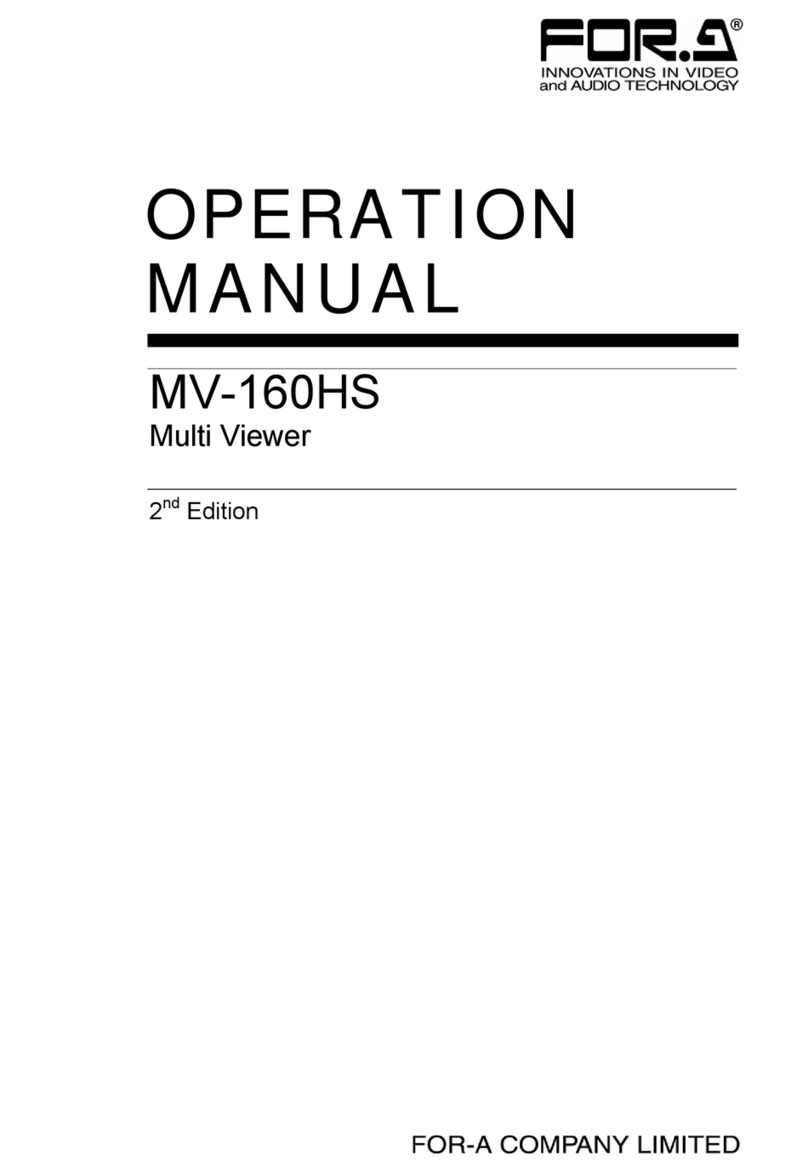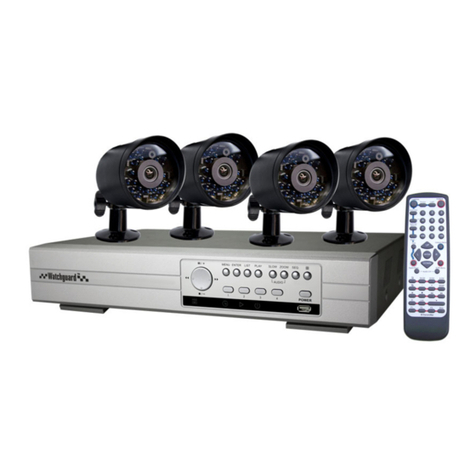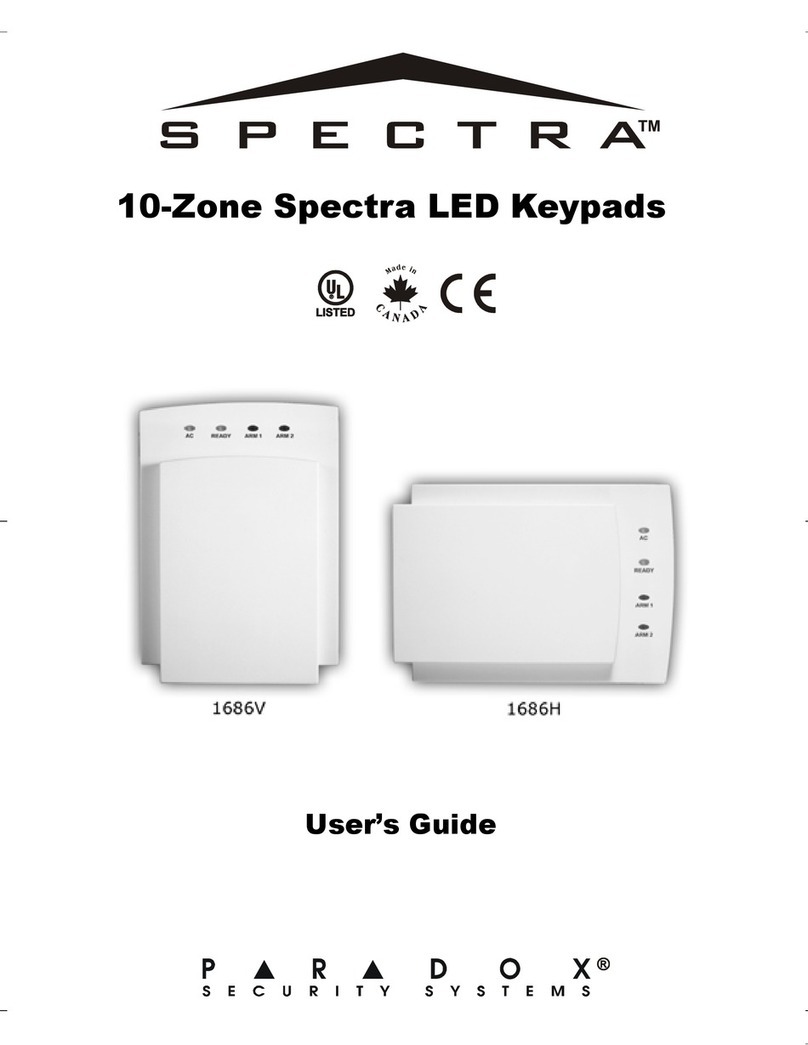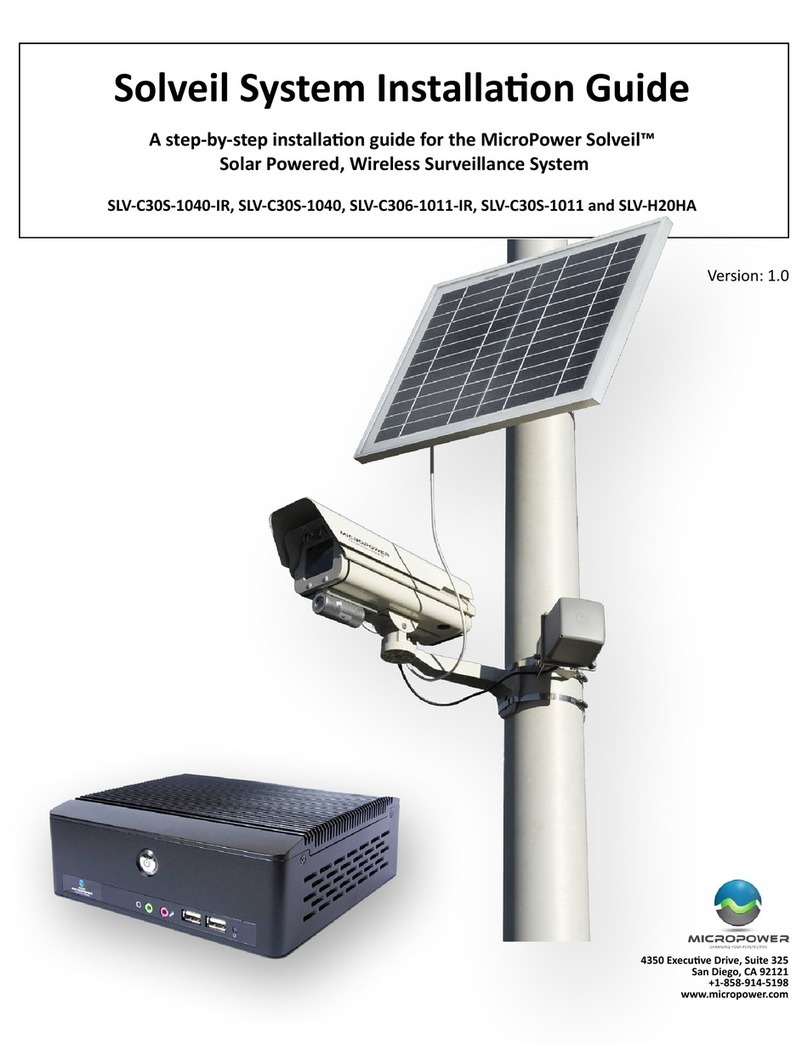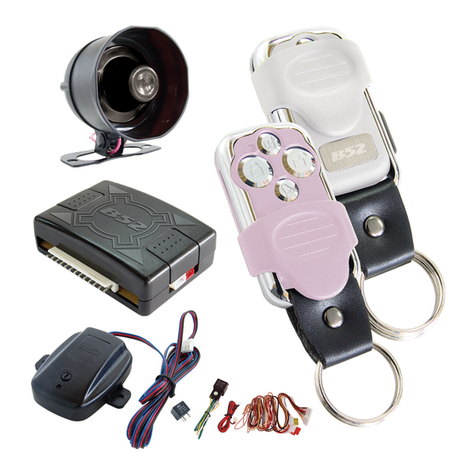Elacompil FPM+ Operator's manual

technical and operational documentation
Doc. version: 3.0.100

Contents
1.
APPLICATION OF THE FPM+ UNIT ..................................................................................................... 4
2.
FPM+ ARCHITECTURE AND TOPOLOGY ............................................................................................. 5
3.
REQUIREMENTS FOR EXTERNAL COMPONENTS .............................................................................. 7
3.1.
FPM+ power supply .......................................................................................................................................................................... 7
3.2.
lectrical installation ......................................................................................................................................................................... 7
4.
FPM+ LIMITATIONS ........................................................................................................................... 8
4.1.
No. of items per bus .......................................................................................................................................................................... 8
4.2.
Length of bus between modules .................................................................................................................................................... 8
4.3.
Length of MP-Bus .............................................................................................................................................................................. 8
4.4.
Number of zones ............................................................................................................................................................................... 8
5.
FPM+ UNIT AND MODULE SPECIFICATIONS ..................................................................................... 9
.
FPM+ MODULES .............................................................................................................................. 15
6.1.
FPM+ control unit - central (MAST R) module ......................................................................................................................... 15
6.2.
LSK ..................................................................................................................................................................................................... 17
6.3.
e.LSK .................................................................................................................................................................................................. 18
6.4.
PSCUS ............................................................................................................................................................................................. 19
6.5.
e.USP..................................................................................................................................................................................................20
6.6.
SKC .....................................................................................................................................................................................................20
6.7.
SKC-A ................................................................................................................................................................................................. 21
6.8.
FPM+ bus repeater module ........................................................................................................................................................... 22
7.
CONNECTING MODULES .................................................................................................................. 24
7.1.
FPM-X-YY-ZZ housings .................................................................................................................................................................. 24
7.2.
PSCUS ............................................................................................................................................................................................. 25
7.3.
e.UPS.................................................................................................................................................................................................. 25
7.4.
LSK ..................................................................................................................................................................................................... 26
7.5.
e.LSK .................................................................................................................................................................................................. 29
7.6.
SKC-A ................................................................................................................................................................................................. 29
7.7.
FPM+ bus repeater .......................................................................................................................................................................... 32
8.
MAIN HOUSINGS FOR CONTROL UNIT MODULES ........................................................................... 33
8.1.
PSCUS ............................................................................................................................................................................................. 33
8.2.
LSK ..................................................................................................................................................................................................... 33
8.3.
SKC ..................................................................................................................................................................................................... 33
8.4.
SKC-A ................................................................................................................................................................................................. 34
8.5.
Main housing of the control unit, type FPM-M-YY-ZZ .............................................................................................................. 34
8.6.
FPM-X-YY-ZZ .................................................................................................................................................................................... 35
8.7.
FPM-U-x-x-x-x-x and FPM-L-x-x-x-x-x ........................................................................................................................................... 36
8.8.
Plastic multiple-module housings ................................................................................................................................................ 36
9.
ASSEMBLY INSTRUCTIONS ............................................................................................................. 40
9.1.
Bus......................................................................................................................................................................................................40
9.2.
Shielding ............................................................................................................................................................................................40
9.3.
xternal power supplies .................................................................................................................................................................40
10.
TYPES OF INPUTS IN THE UNIT ....................................................................................................... 40
10.1.
Input type: unused ........................................................................................................................................................................... 41
10.2.
Input type: digital NO ...................................................................................................................................................................... 41
10.3.
Input type: digital NC....................................................................................................................................................................... 41
10.4.
Input type: digital three-state ........................................................................................................................................................ 42
10.5.
Input type: analog resistive ........................................................................................................................................................... 42
10.6.
Input type: digital supervised NO ................................................................................................................................................. 42
10.7.
Input type: digital supervised NC .................................................................................................................................................. 42
10.8.
Input type: analog 0-5V .................................................................................................................................................................. 43
10.9.
Input type: analog 4-20mA ............................................................................................................................................................ 43

11.
TYPES OF OUTPUTS IN THE UNIT ................................................................................................... 44
11.1.
Output type: relay ............................................................................................................................................................................ 44
11.2.
Output type: Open Collector .......................................................................................................................................................... 44
11.3.
Output type: actuators and appliances compatible with MP-Bus standard ........................................................................ 44
12.
INPUT FUNCTIONS .......................................................................................................................... 45
12.1.
Input function: disabled .................................................................................................................................................................. 45
12.2.
Input function: fire alarm ................................................................................................................................................................ 45
12.3.
Input function: smoke alarm in a duct ........................................................................................................................................ 45
12.4.
Input function: smoke alarm in air intake ................................................................................................................................... 45
12.5.
Input function: smoke warning in air intake ............................................................................................................................... 45
12.6.
Input function: smoke warning in a duct .................................................................................................................................... 45
12.7.
Input function: fire reset ................................................................................................................................................................. 45
12.8.
Input function: firefighting action ................................................................................................................................................. 45
12.9.
Input function: technical alarm ..................................................................................................................................................... 45
12.10.
Input function: ventilation .............................................................................................................................................................. 45
12.11.
Input function: forced air supply from downstairs ................................................................................................................... 45
12.12.
Input function: forced air supply from upstairs ......................................................................................................................... 45
12.13.
Input function: indicator light test ................................................................................................................................................ 45
12.14.
Input function: measurement ....................................................................................................................................................... 45
12.15.
Input function: venting open ......................................................................................................................................................... 45
12.16.
Input function: venting close ......................................................................................................................................................... 46
12.17.
Input function: drive start test....................................................................................................................................................... 46
12.18.
Input function: power failure ......................................................................................................................................................... 46
12.19.
Input function: limit switch ............................................................................................................................................................ 46
12.20.
Input function: limit switch group ................................................................................................................................................ 46
12.21.
Input function: manual control ..................................................................................................................................................... 46
12.22.
Input function: manual fire alarm ................................................................................................................................................. 46
12.23.
Input function: smoke detector alarm ......................................................................................................................................... 46
12.24.
Input function: smoke detector warning ..................................................................................................................................... 46
12.25.
Input function: evacuation with firefighting action ................................................................................................................... 46
12.26.
Input function: general alarm ........................................................................................................................................................ 46
12.27.
Input function: pressure control ................................................................................................................................................... 46
12.28.
Input function: external temperature sensor ............................................................................................................................. 46
12.29.
Input function: internal temperature sensor .............................................................................................................................. 47
12.30.
Input function: upper pressure sensor ........................................................................................................................................ 47
12.31.
Input function: bottom temperature sensor............................................................................................................................... 47
13.
OUTPUT FUNCTIONS ....................................................................................................................... 48
13.1.
Output function: normal fan switch on ....................................................................................................................................... 48
13.2.
Output function: reverse fan switch on ....................................................................................................................................... 48
13.3.
Output function: upper fan rotation direction ............................................................................................................................ 48
13.4.
Output function: lower fan rotation direction ............................................................................................................................. 48
13.5.
Output function: fan switch on with firefighting action ........................................................................................................... 48
13.6.
Output function: evacuation with firefighting action ................................................................................................................ 48
13.7.
Output function: sensor power supply reset .............................................................................................................................. 48
13.8.
Output function: indicator lights ................................................................................................................................................... 48
13.9.
Output function: fire alarm............................................................................................................................................................. 48
13.10.
Output function: technical alarm .................................................................................................................................................. 48
13.11.
Output function: line actuator plus .............................................................................................................................................. 48
13.12.
Output function: line actuator minus ........................................................................................................................................... 48
13.13.
Output function: failure ................................................................................................................................................................... 48
13.14.
Output function: actuator .............................................................................................................................................................. 48
13.15.
Output function: actuator disabled .............................................................................................................................................. 48
13.16.
Output function: cut-off gate ......................................................................................................................................................... 49
13.17.
Input function: pressure regulator ............................................................................................................................................... 49
13.18.
Output function: exhaust bottom ................................................................................................................................................. 49
13.19.
Output function: exhaust top ........................................................................................................................................................ 49
13.20.
Output function: supply bottom ................................................................................................................................................... 49
13.21.
Output function: supply top ........................................................................................................................................................... 49
14.
COMMISSIONING INSTRUCTIONS ................................................................................................... 50

15.
PRODUCT SAFETY PRECAUTIONS .................................................................................................. 51
15.1.
Proper usage regulations ............................................................................................................................................................... 51
15.2.
Periodical inspection and maintenance regulations ................................................................................................................ 51
15.3.
Safety precautions .......................................................................................................................................................................... 51
1 .
PACKAGING, TRANSPORT AND STORAGE ....................................................................................... 53
16.1.
Packaging ......................................................................................................................................................................................... 53
16.2.
Transport regulations ..................................................................................................................................................................... 53
16.3.
Storage regulations ......................................................................................................................................................................... 53
17.
ENVIRONMENT IMPACT .................................................................................................................. 54
LIST OF DRAWINGS ....................................................................................................................................... 55
18.
APPENDIX A: FPM-X-YY-ZZ HOUSING SPECIFICATIONS ................................................................. 5
19.
APPENDIX B : - DRAWINGS OF FPM-X-YY-ZZ HOUSINGS ............................................................... 57
19.1.
FPM-2-YY-ZZ .................................................................................................................................................................................... 57
19.2.
FPM—4-YY-ZZ .................................................................................................................................................................................. 59
19.3.
FPM-6-YY-ZZ .................................................................................................................................................................................... 61
19.4.
FPM-8-YY-ZZ .................................................................................................................................................................................... 63
19.5.
FPM-10-YY-ZZ .................................................................................................................................................................................. 65
20.
APPENDIX C : FPM-U-X-X-X-X-X AND FPM-L-X-X-X-X HOUSING SPECIFICATIONS ......................... 7
21.
APPENDIX D : FPM-U-X-X-X-X-X AND FPM-L-X-X-X-X HOUSINGS - DRAWINGS .............................. 8
21.1.
FPM-U-4-6-0-A-D .............................................................................................................................................................................. 68
21.2.
FPM-U-4-6-18-A-G ........................................................................................................................................................................... 69
21.3.
FPM-U-4-6-0-B-D .............................................................................................................................................................................. 69
21.4.
FPM-U-4-6-18-B-G ...........................................................................................................................................................................70
21.5.
FPM-U-6-6-0-A-D ..............................................................................................................................................................................70
21.6.
FPM-U-6-6-26-A-G ........................................................................................................................................................................... 71
21.7.
FPM-U-6-6-0-B-D .............................................................................................................................................................................. 71
21.8.
FPM-U-6-6-26-B-G ........................................................................................................................................................................... 72
21.9.
FPM-L-8-6-0-A-D .............................................................................................................................................................................. 72
21.10.
FPM-L-8-6-18-A-G ............................................................................................................................................................................ 73
21.11.
FPM-L-8-6-0-B-D .............................................................................................................................................................................. 73
21.12.
FPM-L-8-6-18-B-G ............................................................................................................................................................................ 74
22.
APPENDIX E: CUSTOM HOUSINGS .................................................................................................. 75

Page 4 of 78
1. APPLICATION OF THE FPM+ UNIT
The FPM Plus fire alarm control panel is a modular device
for monitoring the operating status and control of all the
pieces of equipment triggered as a result or during a fire.
These can be dedicated firefighting systems, such as:
Fire emergency ventilation system,
Fire shutdown systems,
vacuation support system,
Other building systems triggered to do any action as a result
of fire.
Other systems include:
Access control system,
Burglary and robbery alarm system,
scalator,
Lifts,
Utilities control (shut-off) systems,
Heat pumps and HVAC systems.
The unit features integration of various types of systems
(with different functions) and building a single control
algorithm (control matrix).
9) (…) equipment (fixed or semi-fixed, actuated manually or
automatically) having the function of prevention, detection
and putting out or containment of fires, particularly fixed or
semi-fixed fire extinguishing and fire protection systems,
inerting systems, voice alarm system and fire alarm system
equipment, including alerting/alarm devices, fire alarm
receiving equipment, damage alert receiving system,
evacuation lighting systems, internal standpipes and
standpipe valves, external standpipes, pumps in fire water
pumping stations, fire dampers, smoke extraction
equipment, explosion prevention and containment
equipment, smoke curtains and doors, fire doors and other
fire rated closures if fitted with control systems, fire
emergency power shutdown devices, and hoists for rescue
teams;
The control unit is responsible for technical handling of fire
controls in the building. In response to an alarm from the Fire
Alarm System, the unit will control all the firefighting
equipment according to the assumed fire scenario.
As a minimum, the link between the Fire Alarm System and
the Control Unit can consist of:
Zone alarms (‘Fire in a zone’) - number of signals equals the
number of zones - signal from FAS to the FPM+control unit,
Feedback alarms - these should be matched to the needs of
the building. Feedback alarms may include notifications of
the control unit operation in fire mode (trigger confirmation),
notifications of damage to the FAS, indications of alarms and
hazards discovered by the control unit (if needed)
Fig. 1 Location of the control unit within the overall fire safety system in the building

Page 5 of 78
2. FPM+ ARCHITECTURE AND TOPOLOGY
The FPM+ unit has a modular design and is composed of
modules of various types with various functions. Specific
modules may be enclosed in separate single-module
housings or in group housings where more than one module
can be placed in each.
All the modules are connected with a bus loop. very module
on the bus is addressable. Information is exchanged digitally
between the modules.
The MAST R module is unique among all the unit modules.
This is the main module of the unit, with the function of
overseeing the exchange of information between the other
modules and the exchange of information between the
control unit and the higher level system (BMS, firefighting
equipment integration system). The MAST R module with
additional control unit handling items (buttons and indicator
lights) is always housed in a separate housing (main
housing of the control unit). Together with the MAST R, this
housing can accommodate the power supply and a
maximum of two PSCUS controllers.
Other modules can be housed in ABS housings or steel
housings.

Page 6 of 78
Fig. 2 Control unit topology diagram

Page 7 of 78
3. REQUIREMENTS FOR EXTERNAL COMPONENTS
3.1. FPM+ POWER SUPPLY
The FPM+ modules, according to type, can be powered from:
The control unit internal power supply,
xternal power supply,
Mains power ~230V.
Mains power can only be used when the unit performs
control and monitoring functions over systems which are
not required to work during a fire. An example system of this
type can be a fire damper control system. In this case, mains
voltage or secure voltage from external power supply units
can be used.
If the FPM+ is expected to monitor and control equipment
and systems which are required to operate during a fire, all
the FPM+ modules should be powered with a buffered
power supply, certified for conformity with N-PN 54-4 or
N-PN12101-10, with the supply voltage and output current
appropriate for the specific application.
3.2. ELECTRICAL INSTALLATION
lectrical installation should be built with flame retardant or
non-flammable cables. The choice of cable depends on the
use of the FPM+ unit in the building. If the FPM+ controls
any equipment or systems which are required to operate
during a fire, a non-flammable cable must be used. If the
FPM+ controls any equipment or systems which are not
required to operate during a fire, a flame retardant cable can
be used.
The general rule is that if at least one system or one
appliance connected to the FPM+ must be operating during
a fire, FPM+ action at the time of fire must be assured.
Therefore, the bus and controller power supply installations
must be wired in non-flammable cables. Connections to
appliances and systems should be wired with a cable
adequate for the requirements prevailing in the building.
For fire safety applications, Certificates of Approval should
be issued for the cables by CNBOP-PIB Scientific and
Research Center for Fire Protection National Research
Institute.
Cable ways for fire safety applications should be produced
to appropriate rating, i.e. 30/ 60/ 90, etc. For a specific
application. Conformity with the classification requirements
should be verified by an appropriate certificate.
xample cables:
YnTKSYekw 1x2x0.8 – fire retardant cable for wiring
installations not required to operate during a fire. Can be
used for example to wire a bus linking the modules, or to wire
an MP-Bus.
HTKSHekw PH90 1x2x1 – fire resistant cable for wiring
installations required to operate during a fire. Can be used for
example to connect bus lines.
HDGs 2x1 – fire resistant cable for power supply and control
of systems which need to be powered with electricity during
a fire.
The designer should always make sure that the cable they
intend to use has the requisite approvals and certificates
required by law.

Page 8 of 78
4. FPM+ LIMITATIONS
4.1. NO. OF ITEMS PER BUS
In terms of technical feasibility, a maximum of 254
controllers can be covered within a single bus. These
modules are divided into two groups:
126 x LSK / e.LSK controllers
126 x PSCUS/e.USP controllers
LSK/e.LSK modules have an address pool attributed on
bus 1..126, while the pool attributed to PSCUS/e.UPS
modules is 129…254.
LSK controllers can be addressed on the basis of settings
of controls on the front panel of the respective module, or
on the basis of controller serial numbers.
PSCUS, e.USP and e.LSK controllers are addressed on the
basis of controller serial numbers.
4.2. LENGTH OF BUS BETWEEN
MODULES
The bus is divided into sections. ach module on the bus
is the end and the start of the respective sections to which
it is connected. The length of sections between specific
modules should not exceed 1200 meters.
4.3. LENGTH OF MP-BUS
The overall length of a single MP-Bus (connecting 8
actuators with a single LSK module) should not exceed
600 meters.
4.4. NUMBER OF ZONES
Notwithstanding the number of all zones (fire, control,
smoke extraction zones) that can be covered by the FPM+
unit, there is a limitation of the number of zones to which
a specific output can be assigned. This number is limited
to 70 in the software. Should outputs ( PSCUS and e.USP
relay outputs and LSK and e.LSK actuators) need to be
assigned to a higher number of zones, contact the FPM+
unit manufacturer.

Page 9 of 78
5. FPM+ UNIT AND MODULE SPECIFICATIONS
Table 1 FPM+ unit and module specifications
G N RAL D SCRIPTION
FPM+ architecture Modular, loop, addressable unit
Climate class 2
Loops 1x
Minimum no. of modules 1x, as per 3.1.1 of this approval
Maximum no. of modules 1 MAST R
126 PSCUS/e.USP
126 LSK or LSK/24 or e.LSK
2016 SKC, SKC-A (using 126 e.LSK), or 1008 SKC, SKC-A (using 126 LSK)
A MAST R module is required for more than 1 module
Max. bus voltage 5VDC
Max. bus current Short-circuit current 50mA (limited with a polyfuse)
IP IP42 for external housing of the control unit and individual housings
IP55 for SKC modules
IP65 for LSK and LSK/24 modules
Operating temperature range -50C to +550C (relative humidity 80% at 550C)
Dimensions (L x W x H) Min. 500x600x250
Other dimensions as per the control unit documentation
Firmware version FPMplus
Manual/auto options Automatic, through a signal from the fire alarm system control panel, smoke
extraction system control panel, or automatic smoke detectors of the fire
alarm system.
Manual trigger with the smoke extraction button
Manual control from the integrating system
Systems and appliances integrated
with the control unit
Fire alarm control panels
Smoke and heat propagation control system components (shut-off dampers,
smoke vents, fire vents, smoke curtains, etc.)
Conventional fire detectors (readings on parametric lines)
Smoke extraction buttons and manual call points
Pressure sensors
Temperature sensors
Wind direction and wind force detectors
Voltage presence detectors
Fire dampers
lectromagnetic holders (releases)
Voice alarm systems
Fixed fire extinguishing equipment
mergency exit controls
Other building control systems
Intermediary devices, such as: contacts, inverters, switches

Page 10 of 78
Other external appliances and systems that may or must be controlled during
a fire, where the design and operating mode makes them integrable with the
control unit
Other systems and appliances without firefighting functions where the
design and operating mode makes them integrable with the control unit
POW R SUPPLY D SCRIPTION
Power supply xternal power supply conforming to PN- N12101-10 and PN- N 54-4
Dedicated control unit power supply, type CAM L ON, series ZM24VxxA-
yyyPZ(C), specifically
ZM24V6A-151PZ(C), ZM24V8A-200PZ(C) ZM24V12A-300PZ(C), ZM24V16A-
400PZ(C) and ZM24V24A-600PZ(C)
~230V mains for LSK module
Supply voltage 24-48VDC from external power supply
For LSK module powered from ~230VAC mains
Max. power consumption 2A @ 24VDC (excluding power supply to appliances, such as actuator,
holders, etc.)
Internal operating voltage 24-48VDC
Power supply type or other
identification
CAM L ON
ZM24V24A-600PZ(C)
Operating temperature range -25..70°C
Housing protection grade n.a. (installed in multiple-module IP42 housing)
Dimensions (L x W x H) 262x111x66mm
With connections 279x111x66mm
Main power supply: supply voltage 184..230..253VAC
230 V AC (-20% / +10%)
Max. power consumption from
mains
2.1A
Max. continuous load on power
supply
I
maxA
=18A
Max. short-term load on power
supply
I
maxB
=24A
Ripples 150mV
Uninterrupted power supply: battery
type
AGM type (VRLA) lead acid batteries
Max. battery capacity 120Ah
Battery charging voltage in buffer
mode
26.4…..28.8V
Max. battery charging current 6A
Battery cut-off voltage <21.0V
Max. resistance of battery bank
circuit
100mΩ
Output circuits: power supply output
voltage range
21.0…28.8V
Functional class A

Page 11 of 78
nvironmental class 2 (when installed in the control unit in IP42 housing)
OUTPUTS D SCRIPTION
Potential-free relay outputs
Potential-free relay contacts
Contact type: changeover
Current capacity: 2A for 30VDC
Resistance of contacts: < 50mΩ
For loads with higher current or voltage, use additional high current relays
Number of zones assignable to a single output: 70
OC outputs OC type outputs
Max. external voltage 48VDC
Current capacity: 100mA per output at 25°C
Induction load operation only with idling diode!
MP-Bus outputs MP-Bus output
No. of items on bus: 8
Operating voltage >20VDC
Maximum current >10mA
Maximum outputs MP-Bus: 126*8 = 1008 x MP-Bus devices for LSK, 2016 for e.LSK
Relay outputs: 1008
O/C: 756
INPUTS D SCRIPTION
Digital inputs Digital inputs, supervised, with the option of switching off supervision (NO,
NC mode)
Typical line resistance values
Supervision state 1kΩ
Alarm state 3,3kΩ
Analog inputs Analog inputs for signal acquisition:
4..20mA (with external resistor)
0..5V direct
0..10V with external resistor
Max. inputs Digital, monitored: 504
Digital/analog (configurable): 1008 for PSCUS, 2016 for e.LSK
Recommended cable types For control unit bus: non-flammable cables (for fire ventilation systems and
smoke extraction systems) or flame retardant cables (for fire damper
control), single pair, shielded. Min. core section 0.5mm
Sample cables:
Flame retardant YnTKSYekw 1x2x0.8
Fire resistant HTKSHekw 1x2x1.0 PH90
If the control unit covers at least one appliance requiring uninterrupted power
supply during a fire alarm, fire resistant cables should be used to produce the
bus, in accordance with the applicable legal requirements, including § 187 of
Regulation of the Minister of Infrastructure of 12 April 2002 concerning

Page 12 of 78
technical requirements applicable to buildings and their locations (Journal of
Laws No. 75, item 690, as amended).
For powering actuators - cables should be selected in accordance with the
legal requirements, including § 187 of Regulation of the Minister of
Infrastructure of 12 April 2002 concerning technical requirements applicable
to buildings and their locations (Journal of Laws No. 75, item 690, as
amended).
.g. fire resistant cable HDGs 2x1
Use of a flame retardant cable, e.g. YnTKSYekw 3x2x0.8, is permitted for
powering and controlling appliances for which uninterrupted power supply is
not required during a fire (e.g. fire cut-off dampers with springreturn
actuator).
If the appliances connected to the control unit require the use of cabling with
varying flammability classifications, use highest rated cables out of the
applicable requirements to build the bus.
Cables must be provided with relevant approval documents for use in fire
protection installations (Certificate of conformity, Certificate of Approval by
CNBOP-PIB Scientific and Research Center for Fire Protection National
Research Institute).
Supply voltage 24-48VDC
IP n.a. (installed in multiple-module IP42 housing)
No. of inputs Digital/analog inputs: 8
No. of outputs Relay outputs: 8
FPM+ bus 2xRS485
Configuration/visualization bus thernet
PSCUS module D SCRIPTION
Supply voltage 24-48VDC
IP n.a. (installed in multiple-module IP42 housing)
IP42 – for individual housing with ABS
No. of inputs Digital/analog inputs: 8
No. of outputs Relay outputs: 8
O/C outputs: 6
FPM+ bus 2xRS485
LSK and LSK/ MODUL D SCRIPTION
Supply voltage 24 - 48VDC for LSK/24
230VAC for LSK
IP IP65
No. of inputs Digital inputs: 4
No. of outputs MP-Bus: 1
FPM+ bus 2xRS485

Page 13 of 78
FPM+ BUS R P AT R MODUL D SCRIPTION
Supply voltage 24VDC
IP n.a. (installed in multiple-module IP42 housing)
No. of inputs 2x RS485
SKC module D SCRIPTION
Supply voltage 230VAC
IP IP55
No. of inputs n/a (power supply module)
No. of outputs 24VAC power supply output
SKC-A MODUL
Supply voltage 230VAC or 24VAC or 24VDC
IP IP42
No. of inputs MP-Bus: 1
Analog actuator limit switches: 1
No. of outputs 230VAC or 24VDC control output
MP-Bus: 1
e.LSK MODUL D SCRIPTION
Supply voltage 24-48VDC/VAC
IP IP 20 for the module itself
IP 42 for steel housings (module installed in FPM+ multiple-module housing)
IP 42 for ABS housings (module installed in same housing as SKC-A)
Maximum power consumption 2.4W @ 24VDC
In/out lines System bus – 2x – IA-485 (RS-485) standard, galvanically isolated
MP-BUS – 2 x – MP-BUS standard
System bus voltage +/-5VDC
Max. bus current in supervised state 50mA (typical 0.05mA)
Dimensions 88 x 108 x 62 mm
In ABS housing: 172 x 132 x 78 mm
Weight ca. 180 g
In ABS housing: 450 g
e.USP MODUL D SCRIPTION
Supply voltage 24-48VDC/VAC

Page 14 of 78
IP IP 20 for the module itself
IP 42 for steel housings (module installed in FPM+ multiple-module housing)
IP 42 for ABS housings (module installed in same housing as PSCUS)
Maximum power consumption 2.4W @ 24VDC
In/out lines
System bus – 2x – IA-485 (RS-485) standard, galvanically isolated
Inputs – 16 x
Outputs – 8 x - relays
System bus voltage +/-5VDC
Max. bus current in supervised state 50mA (typical 0.05mA)
Dimensions 214 x 108 x 62 mm
In ABS housing: 252 x 202 x 90 mm
Weight ca. 400 g
In ABS housing: 1100 g

Page 15 of 78
. FPM+ MODULES
The FPM Plus system is composed of multiple units (the
central module and local modules) with different functions.
The central module monitors the service of local controllers
and facilitates communication between them.
Modules are set up in FPM+ Configurator.
.1. FPM+ CONTROL UNIT - CENTRAL (MASTER) MODULE
The master module of FPM+ control unit has the following
functions:
exchange of information between other modules
monitoring loop continuity
connection of FPM+ unit with a visualization system (BMS,
SMS).
Fitted with thernet port, two RS485 ports, an RS232 port,
eight relay outputs, and eight inputs.
The communication ports as well as two 5A@VDC relays are
installed on the main board of the module, while the inputs
and the six additional 1A@30VDC outputs are located on the
extension board.
Module inputs are used to monitor and control the unit
(managing lights, buttons, access key).
The main unit housing consists of: the housing itself, a
control & alert panel, a power supply with batteries (the
power supply and batteries can be waived upon request and
the unit can be powered from an external certified power
supply), installation pieces (cable grommets, DIN bus bars,
cable trays).
Fig. 3 FPM+ unit housing (MAST R housing)

Page 16 of 78
A control & alert panel is located on the main housing of the FPM+ unit, fitted with the following controls:
Fig. 4 Control panel
Confirm button
for shutting down voice alarms
Reset button
for a fire reset triggered from access level 2
Power light
indicates that the unit is powered and working
Malfunction light
indicates that the unit has discovered a malfunction
Fire light
indicates that the unit is in the fire state
Locked light
indicates that the unit has certain components in locked state

Page 17 of 78
.2. LSK
The LSK module is designed for controlling and monitoring
actuators and other devices fitted with MP-Bus interface.
Such actuators may include:
fire shut-off damper actuators (e.g. BF24-TL-T-ST),
line actuators of air dampers in HVAC systems, and slide
valves (e.g. LH24A-MP, NM24A-MP, SM24A-MP, GM24A-MP)
SA actuators for dampers and louvres (e.g. LU24A-MP)
actuator valves for water installations (e.g. LV24A-MP-TPC,
NVC24A-MP-TPC)
actuators for water installation valves (e.g. LR24A-MP)
VAV regulators (e.g. LMV-D3-MP)
air pressure regulators (e.g. VRP-M)
Apart from devices supporting the MP-BUS standard, the LSK
module can also control and monitor analog equipment
items, e.g. fire damper actuators. In order to support such
devices, the LSK must be connected to SKC-A module.
The LSK module is also fitted with four potential-free signal
inputs. These inputs can operate in supervised, NO or NC
modes. For the purpose of receiving alarm signals from the
FAS, an input should be configured in line supervision mode.
The primary method of installation of an LSK module is to
place it in a separate housing in the building, near the
equipment it supervises.
Two versions of LSK modules are available: fitted for 230VAC
or 24VAC/VDC power supply. The difference between these
modules is the non-existence of a transformer in the power
system. Besides, the modules are identical and have the
same properties.
Fig. 5 LSK module

Page 18 of 78
.3. E.LSK
The e.LSK is a more recent version of LSK, a module
designed for controlling and monitoring actuators and other
devices fitted with MP-Bus interface.
Fig. 6 e.LSK module
Below are the primary differences between e.LSK and LSK:
e.LSK is fitted with two MP-Bus items (1 bus in LSK), capable
of accommodating up to 16 actuators (8 actuators can be
connected to an LSK module);
no trip inputs in e.LSK (there are 4 trip inputs in an LSK
module);
different installation method: by default, e.LSK should be
installed in a multiple-module housing of the FPM+ unit on a
DIN bus bar, while LSK is installed in a separate housing.
The primary method of installation of an LSK module is to
place it in a multiple-module housing of the FPM+ unit, while
an e.LSK can be installed in a separate housing in the
building, near the equipment it supervises. Such additional
housing for e.LSK is the same as that for SKC-A.
e.LSK modules are powered with 24- 40VDC/VAC voltage.

Page 19 of 78
.4. EPSCUS
PSCUS is the primary control and monitoring module of an
FPM+ unit. It can receive potential-free signals from external
equipment and systems, and is fitted with 8 relay outputs for
controlling external hardware.
In addition, an PSCUS module has 6 OC outputs which can
be used for connecting indicator elements, such as lights.
A module adapted to measurement of analog values from
different types of detectors is referenced as PSCUS(A).
An PSCUS module can be placed:
in the main housing, together with the MAST R module -
max. 2 items;
in one of the steel housing versions (OZ-FPMPLUS-xx or
OBZ-FPMPLUS-xx);
in an ABS housing for a single module.
PSCUS modules are installed in multiple-module housings
on a DIN bus bar.
The choice of the specific housing and number of modules
in a housing depends on the building design and the need to
build a control system for fire safety equipment.
The PSCUS model is designed for 12-48VDC.
Fig. 7 PSCUS module
Table of contents
Popular Security System manuals by other brands
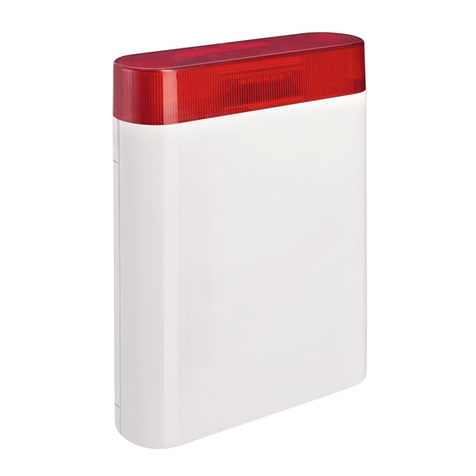
Abus
Abus FUSG50101 Installation instructions and user manual
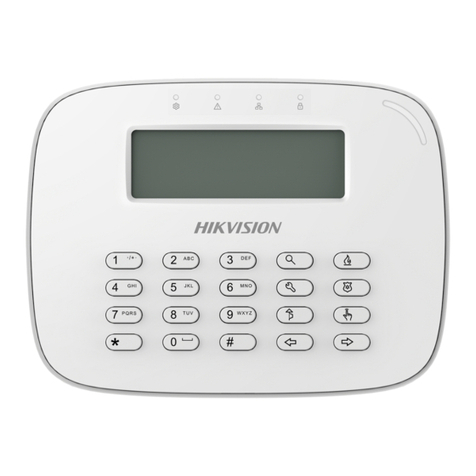
HIK VISION
HIK VISION DS-PK-LRT Product information

Fire-Lite
Fire-Lite Fire-Lite Alarms BB-26 Specifications
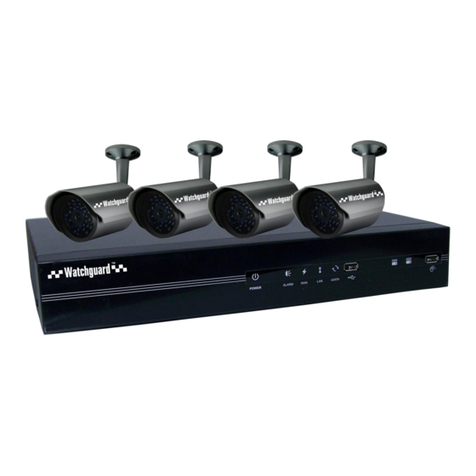
Watchguard
Watchguard NVR4ENTPACK v1.2 Quick installation guide
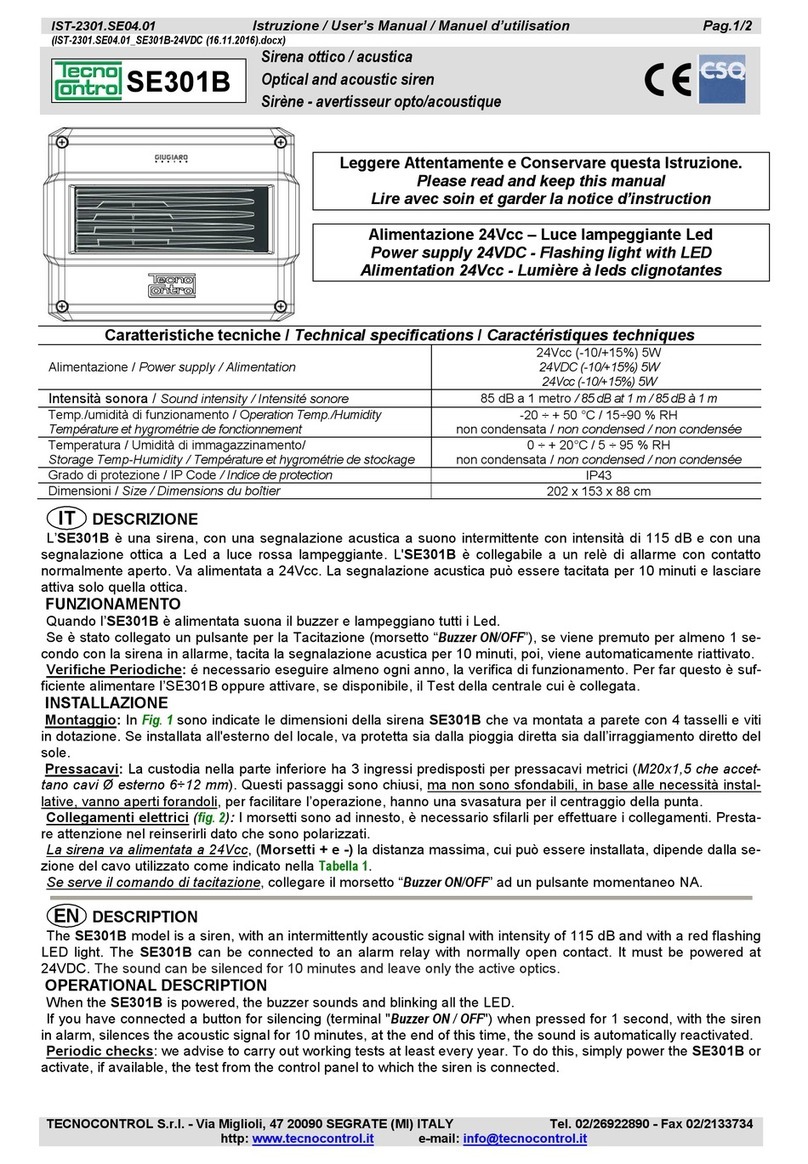
Tecnocontrol
Tecnocontrol SE301B user manual
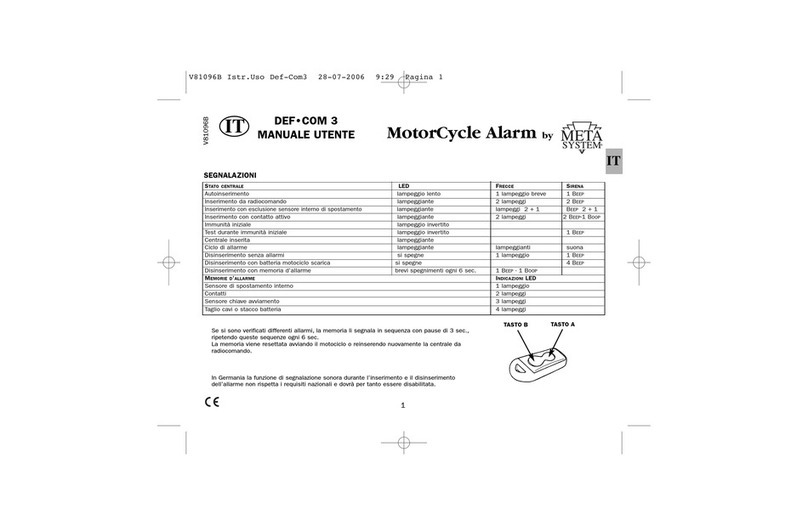
MetaSystem
MetaSystem Def Com 3 Operation manual

